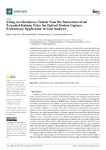Mostrar o rexistro simple do ítem
Using Accelerometer Data to Tune the Parameters of an Extended Kalman Filter for Optical Motion Capture: Preliminary Application to Gait Analysis
| dc.contributor.author | Cuadrado, Javier | |
| dc.contributor.author | Michaud, Florian | |
| dc.contributor.author | Lugrís-Armesto, Urbano | |
| dc.contributor.author | Pérez Soto, Manuel | |
| dc.date.accessioned | 2021-02-23T16:00:58Z | |
| dc.date.available | 2021-02-23T16:00:58Z | |
| dc.date.issued | 2021-02 | |
| dc.identifier.citation | Cuadrado, J.; Michaud, F.; Lugrís, U.; Pérez Soto, M. Using Accelerometer Data to Tune the Parameters of an Extended Kalman Filter for Optical Motion Capture: Preliminary Application to Gait Analysis. Sensors 2021, 21, 427. https://doi.org/10.3390/s21020427 | |
| dc.identifier.issn | 1424-8220 | |
| dc.identifier.uri | http://hdl.handle.net/2183/27353 | |
| dc.description.abstract | [Abstract] Optical motion capture is currently the most popular method for acquiring motion data in biomechanical applications. However, it presents a number of problems that make the process difficult and inefficient, such as marker occlusions and unwanted reflections. In addition, the obtained trajectories must be numerically differentiated twice in time in order to get the accelerations. Since the trajectories are normally noisy, they need to be filtered first, and the selection of the optimal amount of filtering is not trivial. In this work, an extended Kalman filter (EKF) that manages marker occlusions and undesired reflections in a robust way is presented. A preliminary test with inertial measurement units (IMUs) is carried out to determine their local reference frames. Then, the gait analysis of a healthy subject is performed using optical markers and IMUs simultaneously. The filtering parameters used in the optical motion capture process are tuned in order to achieve good correlation between the obtained accelerations and those measured by the IMUs. The results show that the EKF provides a robust and efficient method for optical system-based motion analysis, and that the availability of accelerations measured by inertial sensors can be very helpful for the adjustment of the filters. | es_ES |
| dc.description.sponsorship | This work was funded by the Spanish MCI under project PGC2018-095145-B-I00, co-financed by the EU through the EFRD program, and by the Galician Government under grant ED431C2019/29. Moreover, F. Michaud would like to acknowledge the support of the Spanish MCI by means of the doctoral research contract BES-2016-076901, co-financed by the EU through the ESF program | es_ES |
| dc.description.sponsorship | Xunta de Galicia; ED431C2019/29 | |
| dc.language.iso | eng | es_ES |
| dc.publisher | MDPI | es_ES |
| dc.relation | info:eu-repo/grantAgreement/AEI/Plan Estatal de Investigación Científica y Técnica y de Innovación 2017-2020/PGC2018-095145-B-I00/ES/ESTUDIO DE LA RELACION ENTRE EFICIENCIA Y NIVEL DE DETALLE EN MODELOS BIOMECANICOS DEL CUERPO HUMANO | |
| dc.relation | info:eu-repo/grantAgreement/AEI/Plan Estatal de Investigación Científica y Técnica y de Innovación 2013-2016/BES-2016–076901/ES/ | |
| dc.relation.uri | https://doi.org/10.3390/s21020427 | es_ES |
| dc.rights | Atribución 4.0 Internacional | es_ES |
| dc.rights.uri | http://creativecommons.org/licenses/by/4.0/ | * |
| dc.subject | Kalman, Filtro de | es_ES |
| dc.subject | Biomecánica | es_ES |
| dc.subject | Marcha humana | es_ES |
| dc.subject | Inercia (Mecánica) | es_ES |
| dc.subject | Sensores de desplazamiento | es_ES |
| dc.title | Using Accelerometer Data to Tune the Parameters of an Extended Kalman Filter for Optical Motion Capture: Preliminary Application to Gait Analysis | es_ES |
| dc.type | info:eu-repo/semantics/article | es_ES |
| dc.rights.access | info:eu-repo/semantics/openAccess | es_ES |
| UDC.journalTitle | Sensors | es_ES |
| UDC.volume | 21 | es_ES |
| UDC.issue | 2 | es_ES |
| UDC.startPage | 1 | es_ES |
| UDC.endPage | 22 | es_ES |
| dc.identifier.doi | 10.3390/s21020427 |
Ficheiros no ítem
Este ítem aparece na(s) seguinte(s) colección(s)
-
LIM - Artigos [52]






